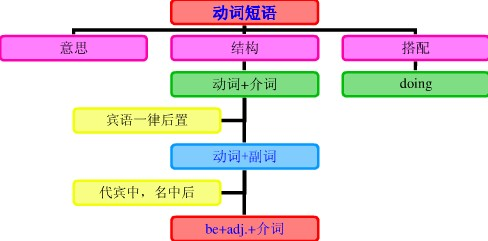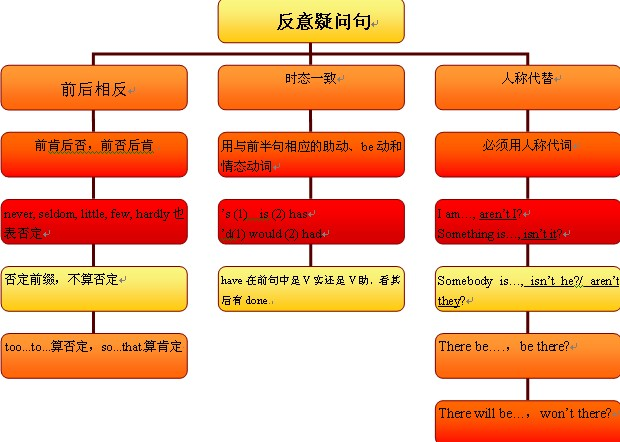本试题 “—I don't like the plan they put forward. You have never______ it, haven't you?—______, I seriously doubt its future.[ ]A. approved of; NoB. agree w...” 主要考查您对动词短语
反意疑问句
等考点的理解。关于这些考点您可以点击下面的选项卡查看详细档案。
- 动词短语
- 反意疑问句
动词短语的概念:
动词常和某些其他词类用在一起,构成固定词组,形成所谓短语动词(phrasalverb)。和动词一样,短语动词也可分为及物和不及物两种。短语动词可以作为一个整体看待,同一般动词一样使用。
动词短语的搭配类型:
1)动词+介词:这类短语动词用作及物动词,后面须跟宾语。
如:The small boy insisted on going with his parents. 那男孩坚持要跟父母一起去。
Do you often listen to broadcasts in English? 你常听英语广播吗?
Look at the children. Aren't they lovely? 看着这些孩子们。他们多么可爱呀!
We stand for self-reliance. 我们是主张自力更生的。
这一类的短语动词还有很多,如depend on(upon)(依靠),wait on(服侍),look for(寻找),deal with(对待),look after(照料),wait for(等待)等。
2)动词+副词:
这类短语动词有的用作及物动词,有的用作不及物动词。
如:I always get up as soon as the bell rings. 我总是一打铃就起床。(不及物)
Look out, there's a car coming! 当心,来汽车了!(不及物)
Have you handed in your exercises already? 你已经交练习了吗?(及物)
Please don't forget to put on your coat, it's cold outside. 请不要忘记穿外衣,外面很冷。(及物)
这一类的短语动词还有很多,及物如put out(扑灭),eat up(吃光),put down(放下);不及物如set off(出发),come up(走近),go on(继续)。
注:"动词+副词"这类短语动词和上面第一类"动词+介词"的不同之处在于:"动词+介词"用作及物动词,后面须跟宾语。"动词+副词"则有的及物,有的不及物;用作及物动词而宾语为人称代词或自身代词时,副词往往放在宾语之后。
如:Please wake me up at five tomorrow. 请在明天早上五点唤醒我。
If you have done your exercises, please hand them in. 如果你们练习做完了请交来。
She doesn't normally behave like that, she's putting it on. 她通常并不如此表现,她是装出来的。
注:这类短语动词有不少可兼作及物和不及物动词用。
如:He took off his hat when he entered the office. 他进办公室后脱下帽子。(及物)
The plane took off at seven sharp. 飞机在七点整起飞。(不及物)
Charlie rang up Neil to ask about the time of the meeting. 查理打电话给尼尔问开会的时间。(及物)
If you can't come, please ring up and let us know. 你如来不了,请来电话告诉我们一声。(不及物)
3)动词+副词+介词:
"动词+副词"之后有的可以再加一个介词,形成另一种短语动词。这类短语动词用作及物动词。
如:Do not give up hope. We must go on with the experiment 不要失望。我们必须继续试验。(go on with继续)
He came up to me. 他走到我跟前。(come up to走近)
这类短语动词还有:look down upon(看不起),do away with(去掉),put up with(忍受)等。
4)动词+名词+介词:
这类短语动词也是及物的。
如:He shook hands with all the guests at the banquet. 他在宴会上和宾客一一握手。
Young pioneers often come to the Children's Palace to take part in after school activities.少先队员经常到少年宫来参加课外活动。
Pay attention to the temperature of the stored rice. 注意仓库里的稻谷的温度。
Her job is taking care of the babies. 她的工作是照顾婴儿。
这一类短语动词还有:put an end to(结束),take notice of(注意),catch hold of(抓住),lose sight of(看不见),make use of(利用)等。
动词短语知识体系:

反意疑问句的概念:
表示提问人的看法,没有把握,需要对方证实。
反意疑问句由两部分组成:前一部分是一个陈述句,后一部分是一个简短的疑问句,两部分的人称时态应保持一致。
1、陈述部分肯定式+疑问部分否定式,可记为前肯后否。
2、陈述部分否定式+疑问部分肯定式,可记为前否后肯。
例如:This pencil is red, isn't it? Yes, it is. / No, it isn't.
This pencil isn't red, is it? Yes, it is. / No, it isn't.
反意疑问句类型:
1)陈述部分的主语是I,疑问部分要用aren't I.
如:I'm as tall as your sister, aren't I?
2)陈述部分的谓语是wish,疑问部分要用may+主语。
如:I wish to have a word with you, may I?
3)陈述部分用no, nothing, nobody, never, few, seldom, hardly, rarely, little等否定含义的词时,疑问部分用肯定含义。
如:The Swede made no answer, did he/she?
Some plants never blown(开花), do they?
4)含有oughtto的反意疑问句,陈述部分是肯定的,疑问部分用shouldn't/oughtn't+主语。
如:He ought to know what to do,oughtn't he?/shouldn't he?
5)陈述部分有have to+v.(had to+v.),疑问部分常用don't+主语(didn't+主语)。
如:We have to get there at eight tomorrow, don't we?
6)陈述部分的谓语是usedto时,疑问部分用didn't+主语或usedn't+主语。
如:He used to take pictures there, didn't he?/usedn't he?
7)陈述部分有had better+v. 疑问句部分用hadn't you?
如:You'd better read it by yourself, hadn't you?
8)陈述部分有would rather+v.,疑问部分多用wouldn't+主语。
如:He would rather read it ten times than recite it, wouldn't he?
9)陈述部分有You'd like to+v.疑问部分用wouldn't+主语。
如:You'd like to go with me, wouldn't you?
10)陈述部分有must的疑问句,疑问部分根据实际情况而定。
如:He must be a doctor, isn't he?
You must have studied English for three years, haven't you?/didn't you?
He must have finished it yesterday, didn't he?
反意疑问句用法总结:
| 陈述部分的谓语 | 疑问部分 |
| I' | aren’t I |
| wish | may + 主语 |
| no, nothing, nobody, never, few, seldom, hardly, rarely, little等否定含义的词 | 肯定含义 |
| ought to(肯定的) | shouldn't/ oughtn't +主语 |
| have to+v.(had to+v.) | don't +主语(didn't +主语) |
| used to | didn't +主语或 usedn't +主语 |
| had better + v. | hadn't you |
| would rather + v. | wouldn't +主语 |
| you'd like to + v. | wouldn't +主语 |
| must | 根据实际情况而定 |
| 感叹句中 | be +主语 |
| neither…nor, either…or 连接的并列主语 | 根据其实际逻辑意义而定 |
| 指示代词或不定代词everything, that, nothing, this | 主语用it |
| 并列复合句 | 谓语根据邻近从句的谓语而定 |
| 定语从句,宾语从句的主从复合句 | 根据主句的谓语而定 |
| think, believe, expect, suppose, imagine等引导 | 与宾语从句相对应的从句 |
| everybody, anyone, somebody, nobody, no one | 复数they, 单数he |
|
情态动词dare或need dare, need 为实义动词 |
need (dare ) +主语 do +主语 |
|
省去主语的祈使句 Let's 开头的祈使句 |
will you?shall we? |
| there be | 相应的谓语动词+there(省略主语代词) |
| 否定前缀不能视为否定词 | 仍用否定形式 |
| must表"推测" | 根据其推测的情况来确定反意疑问句 |
反意疑问句特殊用法点拨:
1、感叹句中,疑问部分用be+主语。
如:What colours, aren't they?
What a smell, isn't it?
2、陈述部分由neither...nor, either...or 连接的并列主语时,疑问部分根据其实际逻辑意义而定。
如:Neither you nor I am engineer, are we?
3、陈述部分主语是指示代词或不定代词everything, that, nothing, this,疑问部分主语用it。
如:Everything is ready, isn't it?
4、陈述部分为主语从句或并列复合句,疑问部分有三种情况:
a.并列复合句疑问部分,谓语动词根据邻近从句的谓语而定。
如:Mr. Smith had been to Bei jing for several times, he should have been in China now, shouldn't he?
b.带有定语从句,宾语从句的主从复合句,疑问部分谓语根据主句的谓语而定。
如:He is not the man who gave us a talk, is he?
He said he wanted to visit Japan, didn't he?
c.上述部分主句谓语是think, believe, expect, suppose, imagine等引导的定语从句,疑问部分与宾语从句相对应构成反意疑问句。
如:I don't think he is bright, is he?
We believe she can do it better, can't she?
5、陈述部分主语是不定代词everybody, anyone, somebody, nobody, noone等,疑问部分常用复数they,有时也用单数he。
如:Everyone knows the answer, don't they?(doeshe?)
Nobody knows about it, do they?(doeshe?)
6、带情态动词dare或need的反意疑问句,疑问部分常用need(dare)+主语。
如:We need not do it again, need we?
He dare not say so,dare you? 当dare, need为实义动词时,疑问部分用助动词do+主语。
如:She doesn't dare to go home alone, does she?
7、省去主语的祈使句的反意疑问句,疑问部分用will you。
如:Don't do that again, will you?
Go with me, will you/won't you? 注意:Let's开头的祈使句,后用shall we? Let us开头的祈使句,后用will you?
如:Let's go and listen to the music, shall we?
Let us wait for you in the reading-room, will you?
8、陈述部分是"therebe"结构的,疑问部分用there省略主语代词。
如:There is something wrong with your watch, isn't there?
There will not be any trouble, will there?
9、否定前缀不能视为否定词,其反意疑问句仍用否定形式。
如:It is impossible, isn't it?
He is not unkind to his classmates, is he?
10、must在表"推测"时,根据其推测的情况来确定反意疑问句。
如:He must be there now, isn't he?
It must be going to rain tomorrow, won't it?
反意疑问句知识体系:

复合句的反意疑问句:
1、当陈述部分是一个(带that引导宾语从句的)主从复合句时,附加疑问句的主谓要和主句的主谓保持对应关系。但是,当陈述部分的主语是:I suppose, I think, I believe, I imagine, I expect等结构时,附加疑问句的主语和谓语要和从句的主语,谓语保持一致关系。而且要注意到否定的转移问题。
如:I think there is something wrong with the washer, isn't there?
We don't suppose he cares, does he?
2、当陈述部分是I'm sure that;we are sure;I'm afraid that;We are sure that;I feel sure that等后面跟宾语从句时,反意疑问句与后面的宾语从句一致。
3、当陈述部分是并列句时,附加疑问句的主谓语要和离它最近的句子的主谓保持对应关系。
如:We must redouble our efforts, or we'll not be able to catch up with the others, will we?
与“—I don't like the plan they put forward. You have never__...”考查相似的试题有:
- ---Many species are now in danger of dying out.----True.Measures should be______to protect them right now.A.takenB....
- He didn't believe it was true until he________her offer of a job.[ ]A.swept upB.sped upC.picked upD.took up
- Though the girl doesn't lose _____ heart to him, he doesn't lose _____ heart. He still works as hard as usual.[ ]A. h...
- We can’t have some students ______ cheating in the exam.A.getting away withB.getting away fromC.get away withD.ge...
- The Great Western Development ___ a bridge between China and the rest world, promoting the common economic developmen...
- Is this your necklace, Mary? I____ it when I was cleaning the bathroom this morning.A.came acrossB.dealt withC.loo...
- The small fishing village has ______ into a modern city in thirty years.A.extendedB.existedC.exploredD.expanded
- Memorial Day is a US national holiday to remember those who gave their lives in the service ofthe nation.[ ]A. set as...
- I asked the gardener to _________all those bushes and plant flowers instead.A.cut outB.cut offC.cut inD.cut down
- The girl _____ to be a good dancer if she is well trained in an art school.A.expectsB.allowsC.wishesD.promises